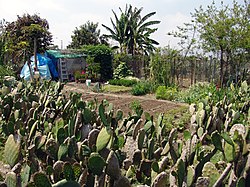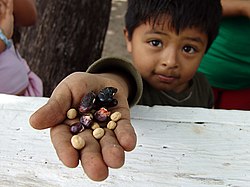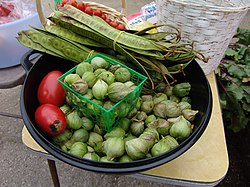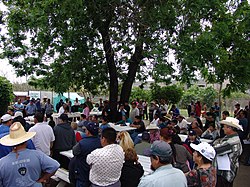This is an old revision of this page, as edited by Anonymous editor (talk | contribs) at 06:51, 17 June 2006 (Reverted edits by 205.188.116.139 (talk) to last version by Rockero). The present address (URL) is a permanent link to this revision, which may differ significantly from the current revision.
Revision as of 06:51, 17 June 2006 by Anonymous editor (talk | contribs) (Reverted edits by 205.188.116.139 (talk) to last version by Rockero)(diff) ← Previous revision | Latest revision (diff) | Newer revision → (diff)| This article documents a current event. Information may change rapidly as the event progresses, and initial news reports may be unreliable. The latest updates to this article may not reflect the most current information. Feel free to improve this article or discuss changes on the talk page, but please note that updates without valid and reliable references will be removed. (Learn how and when to remove this message) |

The South Central Farm, also known as the South Central Community Garden, is an urban farm and community garden located at East 41st and South Alameda Streets in industrialized South Los Angeles, California (formerly known as South Central Los Angeles). At 14 acres (~0.056 km), it is considered to be one of the largest urban farms in the United States.
History
Before the creation of the garden, the land belonged to nine different owners, the largest of which was Alameda-Barbara Investment Company, a real-estate firm which purchased its share in 1980. The company held 80% of the property that would become the present urban garden. The city of Los Angeles acquired the land, by eminent domain, in 1986 for the purpose of building a waste-to-energy incinerator known as the Los Angeles City Energy Recovery Project (LANCER). This idea was abandoned due to community opposition, led by Juanita Tate and Concerned Citizens of South-Central Los Angeles.
The final order of condemnation under eminent domain included a right to repurchase the land should the city sell it for non-public or non-housing purposes within ten years of the condemnation for the largest land owner, Alameda-Barbara Investment Company. The City sold the property to the L.A. Harbor Department in 1994.
July 1994 the Harbor Department granted a revocable permit to the L.A. Regional Food Bank – a private, nonprofit food-distribution network housed across the street from the Lancer site – to occupy and use the site as a community garden.
In 2001, Ralph Horowitz, a partner in former property owner Alameda-Barbara sued the City for breach of contract, for failure to honor the original right of repurchase. The City denied his claim.
In 2003, the City of L.A. settled with Horowitz, in a closed door session. The sale was for $5,050,000 , above the $4.8 million the city paid for it in the eminent domain seizure. Horowitz agreed to donate 2.6 acres of the site for a public soccer field, as part of the settlement. The City Council discussed and approved the terms of the settlement in closed session. The South Central Farm's Lawyer, Patrick Dunlevy, claims that despite repeated requests, negotiation documents relating to the session, have never been released.
Shortly thereafter the Los Angeles regional Foodbank abandoned the project. In response the farmers formed an organization calling themselves the 'South Central Farmers Feeding Families.'
On January 8, 2004, Horowitz issued a notice to the gardeners setting February 29, 2004, as the termination date for the community garden. In response members of the South Central Farmers Feeding Families obtained legal counsel (Hadsell & Stormer, Inc., and Kaye, Mclane & Bednarski LLP) and filed a lawsuit seeking to invalidate the sale of the property. The Los Angeles County Superior Court issued a temporary restraining order and later a preliminary injunction halting development of the property until the lawsuit could be settled. The farmers lost the lawsuit.
Horowitz sought $16.3 million for the property, more then three times the price he paid for it two years ago. In a deal brokered in cooperation by The Trust for Public Land, the SCF have successfully raised a little over six million dollars. Fundraising efforts continued as farmers and celebrities have begun both a tree sitting campaign and occupation of the land, while under the threat of forced eviction by the Los Angeles County Sheriff Department.
On June 7, 2006, the Annenberg Foundation announced that they would donate the money to buy the farm. Horowitz, however, did not respond to the offer, since it came after his May 22 deadline.
At three a.m. on the morning of June 13, 2006, the Los Angeles County Sheriff's department arrived at the farm, fully surrounding it by four a.m. At five a.m., the sheriffs entered the farm, giving the occupants 15 minutes to evacuate. At that point, most of the occupants of the land left, with a few verbal skirmishes reported. Other protestors were removed by force and struck with batons, some reported to have been carried by ambulance. According to the Los Angeles Times, more than 40 protesters were arrested. Actress Daryl Hannah was removed from the walnut tree in which she and another tree-sitter had been protesting the eviction. It was not immediately clear whether or not Hannah was arrested.
Current Status
- As of June 14, 2006, the farm is being protected by a private security company hired by Horowitz to prevent members of the South Central Farm returning to squat on the land. Horowitz has told the Los Angeles Times and KFI that he would not sell the land to them even if they offered him $50 million, due to the picketing of his house and anti-Semitic remarks directed towards him on the controversial website, Voz de Aztlán.
- The City of Los Angeles has provided 7.8 acres of land at an alternate site, which some of the farmers have relocated to and begun cultivating.
- The next court date involved with the case has been set for July 12, 2006. Lawyers for the farmers will attempt to make the case that the sale of the land to Horowitz was conducted through a illegal backroom deal.
- The SCF continues to hold nightly vigils which typically start at 7pm.
Plant life (Biodiversity)



The SCF contains an estimated 100 to 150 species of plants (37 of which have been identified by Dr.Devon G. Peña professor of Anthropology at the University of Washington, Acequia Institute) According to Dr. Peña the inventory of plants present at the farm represent its connection to Mega-Mexico, a Vavilov center, one of the original Anthropological locations where plants were domesticated. This Vavilov center stretches from the southern end of Mexico (Chiapas) up to South-Western United States. Some of the plants present have been reintroduced to the area by the farmers, descendents of the original inhabitants of Meso-America. The relationship between the farmers and the plants is not like modern farming. Many plants that are seen as weeds by modern farmers have multiple uses to immigrant farmers. These plants function as crops, herbal medicine, spiritual use, and/or as companion plants.
- Avocado
- Banana
- Bean
- Butterfly plant
- Cactus
- Calabash
- Chamomile
- Chamomile, Roman
- Chayote
- Chiplin
- Chokecherry
- Dwarf nettle
- Floss silk tree
- Green amaranth
- Guava
- Husk tomato (ground cherry)
- Jimsonweed
- Maize, corn
- Malabar gourd (a.k.a. Fig-leaved gourd)
- Mallow, cheese flower
- Mexican honeysuckle
- Mexican Parseley
- Mexican tarragon
- Pipicha
- Purslane; pigweed
- Pot marigold
- Red Aztec spinach
- Rootbeer plant
- Rose
- Sapodile
- Seepweed
- Silver wormwood
- Small tallowtree
- Snake Plant
- Spurred anoda, Alfafa:buffalo herb; Lucerne
- Succulents
- Sugarcane
- Tomato
- Wormseed
- Yerba mora
The Farmers

The South Central Farmers consist of approximately 350 poor families from the neighboring community. They are a self-governing organization. This group has transformed the property from a junk filled space into one of the largest urban gardens. Since the notification of the impending destruction of the garden, the group has become politically active and have gathered supporters in politics, higher-learning, entertainment, and abroad.
The operating framework of of the SCF is made made up of elected roles recruited from the General Assembly of the farmers. Some of these positions, are publicly visible representatives of the SCF, such as Rufina Juarez and Tezozomoc. These two "voices" are often mistaken for the organization's leaders, because they often need to interact with the outside public. All roles taken by members of the SCF exist solely to fulfill a need or set of needs to continue the healthy life span of the farm. On the farm women fulfill a majority of the roles from accounting to that of lot monitors. Most of the farmers are poor immigrants from Mexico and Central America.
Notable supporters
- Joan Baez, activist and folk singer
- Michael 'Flea' Balzary, of the Red Hot Chili Peppers writing in his Fleamail
- California Green Party
- Zack de la Rocha, lead singer of Rage Against the Machine
- Dr. David Diaz, Professor of Urban Planning at Cal State Northridge
- Leonardo DiCaprio
- Danny Glover, actor
- Daryl Hanna, actress
- Julia "Butterfly" Hill, environmental activist
- Immortal Technique, Hip hop musician
- Ron Kovic
- Tom Morello, of Audioslave and Rage Against the Machine
- Ralph Nader, activist
- Willie Nelson, singer
- Daniel Ortega, Professor of Architecture at UNLV
- Ozomatli
- Dr. Devon G. Peña, Professor of Anthropology University of Washington, The Acequia Institute
- Leslie Radford, Los Angeles Independent Media Center.
- Alicia Silverstone, actress
- Antonio Villaraigosa, Mayor of Los Angeles
Critics
Criticism of the SCF has mainly come from the property's current owner Ralph Horowitz, a partner in both the Alameda-Barbara Investment Company and its current incarnation the Libaw-Horowitz Investment Company. He maintains that his property rights are being denied by the farmers. He also claims that the SCF is not an “open” organization, since the entire city cannot be members nor can all residents have access to farm on the land. To be generous to the community, Horowitz has proposed to build a soccer field for the community, built on a set aside portion of three acres. The field would be accessible to all city residents, unlike the SCF is only accessible to the SCF or by the organization's permission. Horowitz states that the use of the remaining portion of the property would be “market driven”. He has also stated that he would consider giving preference to a “quality tenant”, alleging that anything that he does with the property will generate jobs in the community, unlike its current use by the farmers. Horowitz also makes the claim that the operation of the SCF is not fair since there is no cap on the number of years that a farmer may use his or her plot of land and there also no need to make room for some one else, that the farmers simply want to keep the land forever. Throughout the controversry, Horowitz has been paying $25,000 per month in mortgage and maintenance costs of the property, plus legal fees.
Other critics of the farmers are Los Angeles Councilman Dennis P. Zine, who alleges that the SCF is a confrontational group, Daniel Hernandez who wrote an article about the SCF titled "bushels of complaints". Claims of internal corruption within the South Central Farm such as farmers being evicted for not supporting the actions of Juarez and Tezozomoc have also been made .
According to news stories, some of the farmers have accused SCF leadership of locking them out of their plots for not supporting the protests. Leaders of the South Central Farmers have denied these allegations. Other farmers and former farmers have complained that the protests and protesters made it impossible for them to properly tend to their land. Some have moved to a different community garden.
See also
- Chávez Ravine
- Chicano Park
- Eminent Domain
- Environmental Racism
- Food security
- Indigenous peoples
- People's Park, Berkeley
- Permaculture
- Property
- urban agriculture
References
- Bushel of Complaints, Daniel Hernandez,David Zahniser (contributer), LA Weekly, Tuesday, 21 March 2006.
- Councilman Zine Issues Statement Regarding South Central Farm Incident.
- “Deal to Buy South L.A. Community Garden Running Short on Time”, Steve Hymon, Los Angeles Times, May 20, 2006.
- "Deputies Begin Evicting South L.A. Farmers", CBS2.com, June 13, 2006.
- 14 Acres-Conversations Across Chasms in South Central Los Angeles, Jessica Hoffmann, Christine Petit, et al. Clamor magazine, issue 36, spring 2006.
- Farmers, Celebrities Evicted From Urban Plot, Hector Becerra, Times Staff Writer, 11:19 AM PDT, June 13, 2006.
- Farmers Feeding Families: Agroecology in South Central Los Angeles, Dr. Devon G. Peña, Professor of Anthropology, University of Washington, Acequia Institute Acequia Institute, Lecture presented to the Environmental Science, Policy and Management Colloquium, University of California – Berkeley, October 10, 2005.
- Free Ride Is Over, Investors Business Daily, Posted June,14,2006,
- "The Future at War with the Past", Jamey Hecht, FromTheWinderness.com, 2006.
- History of the South Central Farm, How the community has used the land since 1985, The Newstandard, Jessica Hoffmann, 2006.
- Insult to Injury, Front Lines, Los Angeles City Beat, Perry Crow,March 30, 2006.
- L.A. Garden Shut Down; 40 Arrested, Hector Becerra, Megan Garvey and Steve Hymon, Los Angeles Times, June 14, 2006.
- "L.A. Urban Farmers Fight for Community Garden", Jessica Hoffmann, The New Standard, April 5, 2006.
- "No Place to Play -- Los Angeles Parks Report", The Trust for Public Land, November 2004.
- "Owner Threatens to Raze Garden in Industrial L.A.", National Public Radio.
- "Pledging the Farm", Daniel Hernandez, LA Weekly, June 8 2006.
- POLICE VIOLENCE AT FARM: Interview with Sam Sanchez, defender of the farm, Jun. 15, 2006 at 11:10 PM
- "Preliminary List of Botanical Species Grown At South Central Community Garden". Dr. Devon G. Peña, Tezozomoc.
- Protesters Resist Sheriffs, Developers in Fight to Save LA Farm, Jessica Hoffman, The New Standard, June 16, 2006.
- "Seeds of Dissension Linger-Farmers in the South Central Community Garden decry the loss of the land to a warehouse project. Some plan to resist the bulldozers.", Erika Hayasaki, Los Angeles Times, October 31, 2005.
- The South Central Farmers Official website.
- "Sheriff's deputies arrest protesters at L.A. urban garden", Associated Press report, June 13 2006.
- South Central Farm photos on wikimedia, Jonathan McIntosh, photographer.
- "Tezozomoc: The organizer with South Central Farmers on surviving eviction, feeding the poor, and rethinking city parks" Dean Kuipers, Los Angeles City Beat, April 21, 2005.
- "Third-space Farmers", Devon G. Peña Ph.D., Vision Magazine Catalyst for Conscious Living, Nov 5. Available at: http://www.visionmagazine.com/11_05/la.htm.
- 39 arrested at L.A. urban garden eviction, JACOB ADELMAN, Associated Press Writer, June 13, 2006.
- Urban Farm Lawyers Vow to Fight On, abc7.com, une 14, 2006.
- "Until the Farm is Secure" Leslie Radford, Los Angeles Independent Media Center, May 27, 2006.
- Urban Farmers Will Continue To Fight, Jacob Adelman, The Associated Press, June 14, 2006.
Notes
- "Seeds of Dissension Linger-Farmers in the South Central Community Garden decry the loss of the land to a warehouse project. Some plan to resist the bulldozers.", Erika Hayasaki, Los Angeles Times, October 31, 2005. http://www.latimes.com/news/local/la-me-garden31oct31,1,7435458.story
- ^ History of the South Central Farm How the community has used the land since 1985, Jessica Hoffmann, The New Standard, 2006. http://newstandardnews.net/content/index.cfm/items/3028
- Trouble in the Garden, LA City Beat http://www.lacitybeat.com/article.php?id=3200&IssueNum=138
- http://www.southcentralfarmers.org
- offer made to purchease farm, ktla news, June 8, 2006 http://ktla.trb.com/news/ktla-urbanfarmdeal,0,3671022.story?coll=ktla-news-1
- http://www.latimes.com/news/local/la-me-farm14jun14,1,4832341.story?coll=la-headlines-california
- http://ktla.trb.com/ktla-hannahfarm,0,6321886.story?coll=ktla-home-3
- http://www.latimes.com/news/local/la-me-farm14jun14,0,6058002.story?page=2&coll=la-home-headlines
- http://ktla.trb.com/ktla-hannahfarm,0,6321886.story?coll=ktla-home-3
- Design Principles For Community-Based Collaborative Management of South Central Farm, Los Angeles, Dr. Devon G. Peña, Steven Garret, May 2006.
- http://www.nytimes.com/2006/06/09/us/09farm.html
- http://www.investors.com/editorial/IBDArticles.asp?artsec=20&artnum=2&issue=20060614
- http://www.carpediemfilms.org/bushel_of_complaints.html
Further reading
- "The Effect of Community Gardens on Neighboring Property Values" Vicki Been and Ioan Voicu, NYU Law and Economics Research Paper No. 06-09, March 2006
External links
- South Central Farmers main page
- Google Earth community Link To SCF
- The Trust For Public Land
- USDA Plants Database
- South Central Farm Flickr group
- Save the Farm Blog